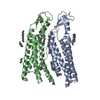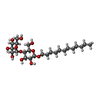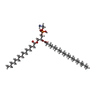[English] 日本語
 Yorodumi
Yorodumi- PDB-7qev: human Connexin 26 at 55mm Hg PCO2, pH7.4:two masked subunits, class D -
+ Open data
Open data
- Basic information
Basic information
| Entry | Database: PDB / ID: 7qev | |||||||||
|---|---|---|---|---|---|---|---|---|---|---|
| Title | human Connexin 26 at 55mm Hg PCO2, pH7.4:two masked subunits, class D | |||||||||
 Components Components | Gap junction beta-2 protein | |||||||||
 Keywords Keywords | MEMBRANE PROTEIN / Gap junction / Ion Channel / carbon dioxide sensitive | |||||||||
| Function / homology |  Function and homology information Function and homology informationTransport of connexons to the plasma membrane / response to human chorionic gonadotropin / epididymis development / gap junction-mediated intercellular transport / gap junction channel activity involved in cell communication by electrical coupling / Oligomerization of connexins into connexons / Transport of connexins along the secretory pathway / gap junction assembly / connexin complex / gap junction ...Transport of connexons to the plasma membrane / response to human chorionic gonadotropin / epididymis development / gap junction-mediated intercellular transport / gap junction channel activity involved in cell communication by electrical coupling / Oligomerization of connexins into connexons / Transport of connexins along the secretory pathway / gap junction assembly / connexin complex / gap junction / gap junction channel activity / astrocyte projection / Gap junction assembly / endoplasmic reticulum-Golgi intermediate compartment / inner ear development / decidualization / lateral plasma membrane / response to retinoic acid / cellular response to glucagon stimulus / cellular response to dexamethasone stimulus / response to progesterone / response to ischemia / sensory perception of sound / transmembrane transport / cell-cell signaling / response to estradiol / cell body / cellular response to oxidative stress / response to lipopolysaccharide / calcium ion binding / perinuclear region of cytoplasm / identical protein binding / plasma membrane Similarity search - Function | |||||||||
| Biological species |  Homo sapiens (human) Homo sapiens (human) | |||||||||
| Method | ELECTRON MICROSCOPY / single particle reconstruction / cryo EM / Resolution: 2.9 Å | |||||||||
 Authors Authors | Brotherton, D.H. / Cameron, A.D. / Savva, C.G. / Ragan, T.J. | |||||||||
| Funding support |  United Kingdom, 2items United Kingdom, 2items
| |||||||||
 Citation Citation |  Journal: Structure / Year: 2022 Journal: Structure / Year: 2022Title: Conformational changes and CO-induced channel gating in connexin26. Authors: Deborah H Brotherton / Christos G Savva / Timothy J Ragan / Nicholas Dale / Alexander D Cameron /  Abstract: Connexins form large-pore channels that function either as dodecameric gap junctions or hexameric hemichannels to allow the regulated movement of small molecules and ions across cell membranes. ...Connexins form large-pore channels that function either as dodecameric gap junctions or hexameric hemichannels to allow the regulated movement of small molecules and ions across cell membranes. Opening or closing of the channels is controlled by a variety of stimuli, and dysregulation leads to multiple diseases. An increase in the partial pressure of carbon dioxide (PCO) has been shown to cause connexin26 (Cx26) gap junctions to close. Here, we use cryoelectron microscopy (cryo-EM) to determine the structure of human Cx26 gap junctions under increasing levels of PCO. We show a correlation between the level of PCO and the size of the aperture of the pore, governed by the N-terminal helices that line the pore. This indicates that CO alone is sufficient to cause conformational changes in the protein. Analysis of the conformational states shows that movements at the N terminus are linked to both subunit rotation and flexing of the transmembrane helices. | |||||||||
| History |
|
- Structure visualization
Structure visualization
| Structure viewer | Molecule:  Molmil Molmil Jmol/JSmol Jmol/JSmol |
|---|
- Downloads & links
Downloads & links
- Download
Download
| PDBx/mmCIF format |  7qev.cif.gz 7qev.cif.gz | 90.9 KB | Display |  PDBx/mmCIF format PDBx/mmCIF format |
|---|---|---|---|---|
| PDB format |  pdb7qev.ent.gz pdb7qev.ent.gz | 61.4 KB | Display |  PDB format PDB format |
| PDBx/mmJSON format |  7qev.json.gz 7qev.json.gz | Tree view |  PDBx/mmJSON format PDBx/mmJSON format | |
| Others |  Other downloads Other downloads |
-Validation report
| Summary document |  7qev_validation.pdf.gz 7qev_validation.pdf.gz | 803.8 KB | Display |  wwPDB validaton report wwPDB validaton report |
|---|---|---|---|---|
| Full document |  7qev_full_validation.pdf.gz 7qev_full_validation.pdf.gz | 807.8 KB | Display | |
| Data in XML |  7qev_validation.xml.gz 7qev_validation.xml.gz | 20.9 KB | Display | |
| Data in CIF |  7qev_validation.cif.gz 7qev_validation.cif.gz | 29.6 KB | Display | |
| Arichive directory |  https://data.pdbj.org/pub/pdb/validation_reports/qe/7qev https://data.pdbj.org/pub/pdb/validation_reports/qe/7qev ftp://data.pdbj.org/pub/pdb/validation_reports/qe/7qev ftp://data.pdbj.org/pub/pdb/validation_reports/qe/7qev | HTTPS FTP |
-Related structure data
| Related structure data |  13942MC  7qeoC  7qeqC  7qerC  7qesC  7qetC  7qeuC  7qewC  7qeyC M: map data used to model this data C: citing same article ( |
|---|---|
| Similar structure data | Similarity search - Function & homology  F&H Search F&H Search |
- Links
Links
- Assembly
Assembly
| Deposited unit | 
|
|---|---|
| 1 |
|
- Components
Components
| #1: Protein | Mass: 26713.674 Da / Num. of mol.: 2 Source method: isolated from a genetically manipulated source Source: (gene. exp.)  Homo sapiens (human) / Gene: GJB2 / Plasmid: pfastbac Homo sapiens (human) / Gene: GJB2 / Plasmid: pfastbacDetails (production host): thrombin-cleavable His6 purification tag Cell line (production host): Sf9 / Production host:  #2: Sugar | ChemComp-LMT / #3: Chemical | #4: Water | ChemComp-HOH / | Has ligand of interest | N | Has protein modification | Y | |
|---|
-Experimental details
-Experiment
| Experiment | Method: ELECTRON MICROSCOPY |
|---|---|
| EM experiment | Aggregation state: PARTICLE / 3D reconstruction method: single particle reconstruction |
- Sample preparation
Sample preparation
| Component | Name: two subunits masked from a dodecameric assembly of human connexin 26: class D Type: ORGANELLE OR CELLULAR COMPONENT / Entity ID: #1 / Source: RECOMBINANT | ||||||||||||||||||||||||||||||||||||||||||||||||||
|---|---|---|---|---|---|---|---|---|---|---|---|---|---|---|---|---|---|---|---|---|---|---|---|---|---|---|---|---|---|---|---|---|---|---|---|---|---|---|---|---|---|---|---|---|---|---|---|---|---|---|---|
| Molecular weight | Experimental value: NO | ||||||||||||||||||||||||||||||||||||||||||||||||||
| Source (natural) | Organism:  Homo sapiens (human) Homo sapiens (human) | ||||||||||||||||||||||||||||||||||||||||||||||||||
| Source (recombinant) | Organism:  | ||||||||||||||||||||||||||||||||||||||||||||||||||
| Buffer solution | pH: 7.4 Details: The buffer, except DDM and DTT, was prepared fresh from 10x stock on day of use. The basal buffer was filtered and de-gassed, and DDM and DTT added. The buffer was pH corrected at point of ...Details: The buffer, except DDM and DTT, was prepared fresh from 10x stock on day of use. The basal buffer was filtered and de-gassed, and DDM and DTT added. The buffer was pH corrected at point of use to 7.4 using 10% CO2 in 90% N2. | ||||||||||||||||||||||||||||||||||||||||||||||||||
| Buffer component |
| ||||||||||||||||||||||||||||||||||||||||||||||||||
| Specimen | Conc.: 3.5 mg/ml / Embedding applied: NO / Shadowing applied: NO / Staining applied: NO / Vitrification applied: YES / Details: This sample monodisperse | ||||||||||||||||||||||||||||||||||||||||||||||||||
| Specimen support | Grid type: UltrAuFoil R1.2/1.3 | ||||||||||||||||||||||||||||||||||||||||||||||||||
| Vitrification | Instrument: LEICA EM GP / Cryogen name: ETHANE-PROPANE / Humidity: 95 % / Chamber temperature: 277 K Details: 3 microlitres protein applied to grid, blot time 6 seconds, in 10% CO2/90%N2 atmosphere |
- Electron microscopy imaging
Electron microscopy imaging
| Experimental equipment |  Model: Titan Krios / Image courtesy: FEI Company |
|---|---|
| Microscopy | Model: FEI TITAN KRIOS |
| Electron gun | Electron source:  FIELD EMISSION GUN / Accelerating voltage: 300 kV / Illumination mode: FLOOD BEAM FIELD EMISSION GUN / Accelerating voltage: 300 kV / Illumination mode: FLOOD BEAM |
| Electron lens | Mode: BRIGHT FIELD / Nominal magnification: 81000 X / Nominal defocus max: 2000 nm / Nominal defocus min: 1000 nm / Cs: 2.7 mm / C2 aperture diameter: 50 µm |
| Specimen holder | Specimen holder model: FEI TITAN KRIOS AUTOGRID HOLDER |
| Image recording | Average exposure time: 5 sec. / Electron dose: 45 e/Å2 / Film or detector model: GATAN K3 (6k x 4k) / Num. of grids imaged: 1 / Num. of real images: 4003 |
| EM imaging optics | Energyfilter name: GIF Bioquantum / Energyfilter slit width: 20 eV |
- Processing
Processing
| Software |
| |||||||||||||||||||||||||
|---|---|---|---|---|---|---|---|---|---|---|---|---|---|---|---|---|---|---|---|---|---|---|---|---|---|---|
| EM software |
| |||||||||||||||||||||||||
| CTF correction | Type: PHASE FLIPPING AND AMPLITUDE CORRECTION | |||||||||||||||||||||||||
| Particle selection | Num. of particles selected: 1679668 / Details: LoG picker implemented in Relion3.1-beta | |||||||||||||||||||||||||
| 3D reconstruction | Resolution: 2.9 Å / Resolution method: FSC 0.143 CUT-OFF / Num. of particles: 18750 / Symmetry type: POINT | |||||||||||||||||||||||||
| Atomic model building | Space: REAL | |||||||||||||||||||||||||
| Atomic model building | PDB-ID: 2ZW3 Accession code: 2ZW3 / Source name: PDB / Type: experimental model | |||||||||||||||||||||||||
| Refinement | Cross valid method: NONE Stereochemistry target values: GeoStd + Monomer Library + CDL v1.2 | |||||||||||||||||||||||||
| Displacement parameters | Biso mean: 106.73 Å2 | |||||||||||||||||||||||||
| Refine LS restraints |
|
 Movie
Movie Controller
Controller










 PDBj
PDBj





